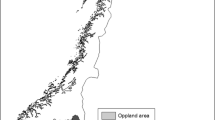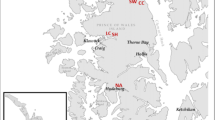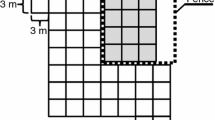Abstract
Ungulate herbivory, interacting with human activities such as tree cutting, can change vegetation structure by reducing tree growth or even increasing tree mortality. There is limited information about how browsing that occurs subsequent to coppicing affects regrowth of resprouting trees, with available data focusing on mature trees and seedlings. To address this knowledge gap, we studied the effect of browsing on the coppice response of resprouting Terminalia sericea trees in a semi-arid savanna in South Africa. The coppice response of browsed trees was compared with that of unbrowsed trees for 12 months after excluding all browsing from study trees. Shoot production was initially higher for browsed coppiced trees, but this effect diminished with time. Resprout shoot diameter and shoot length remained higher throughout the study for unbrowsed coppiced trees. Leaf stomatal conductance and leaf expansion were initially higher for browsed coppiced trees, with no significant differences observed as the wet season progressed. Foliar nitrogen and phosphorus levels were higher in browsed coppiced trees. These tree responses suggest that exposing resprouting trees to browsing initially induces a quick response in terms of shoot production, in order to recover lost biomass, but this growth declines as the growing season progresses.




Similar content being viewed by others
References
Amri E (2011) Germination of Terminalia sericea Buch. ex seeds: the effects of temperature regime, photoperiod, gibberellic acid and potassium nitrate. Int J Appl Biol Pharm Techonol 2:104–110
Archibald S, Bond WJ (2003) Growing tall vs growing wide: tree architecture and allometry of Acacia karroo in forest, savanna, and arid environments. Oikos 102:3–14
Ayres E, Heath J, Possell M, Black HIJ, Kerstiens G, Bardgett RD (2004) Tree physiological responses to above-ground herbivory directly modify below-ground processes of soil carbon and nitrogen cycling. Ecol Lett 7:469–479
Bartos DL, Tshireletso K, Malechek JC (2013) Response of aspen suckers to simulated browsing. For Sci 60:402–408
Carr JD (1994) The propagation and cultivation of indigenous trees and shrubs on the Highveld. Sandton Nature Conservation Society and the Tree Society of Southern Africa, Johannesburg
Chapin FS, Schulze E, Mooney HA (1990) The ecology and economics of storage in plants. Annu Rev Ecol Syst 21:423–447
Cheng L, Fuchigami LH (2002) Growth of young apple trees in relation to reserve nitrogen and carbohydrates. Tree Physiol 22:1297–1303
Coates-Palgrave M (2002) Trees of Southern Africa. In: Coates-Palgrave K (ed) Trees of Central Africa. Struik Publishers, Cape Town
Coley PD, Barone JA (1996) Herbivory and plant defenses in Tropical forests. Annu Rev Ecol Syst 27:305–335
Cutini A, Bongi P, Chiannuci F, Pagon N, Grinolio S, Amorini E, Apollonio M (2011) Roe deer (Capreolus capreolus L.) browsing effects and use of chestnut and Turkey oak coppiced areas. Ann For Sci 68:667–674
Drexhage M, Colin F (2003) Effects of browsing on shoots and roots of naturally regenerated sessile oak seedlings. Ann For Sci 60:173–178
Druege U, Zerche S, Kadner R, Ernst M (2000) Relation between nitrogen status, carbohydrate distribution and subsequent rooting of Chrysanthemum cuttings as affected by pre-harvest nitrogen supply and cold-storage. Ann Bot 85:687–701
Du Toit JT (1990) Regrwoth and palatability of Acacia shoots following pruning by African savanna browsers. Ecology 71:149–154
Eloff JN, Katerere DR, McGaw LJ (2008) The biological activity and chemistry of the southern African Combretaceae. J Ethnopharmacol 119:686–699
Field CB (1983) Allocating leaf nitrogen for maximization of carbon gain: leaf age as a control on the allocation program. Oecologia 56:341–347
Fornara DA, Du Toit JT (2007) Browsing lawns? Responses of Acacia nigrescens to ungulate browsing in an African savanna. Ecology 88:200–209
Griffiths ME (1959) A revision of the African Species of Terminalia. J Linn Soc London Bot 25:364
Guillet C, Bergstrom R, Oksanen L (2006) Compensatory growth of fast-growing willow (Salix) coppice in response to simulated large herbivore browsing. Oikos 113:33–42
Hann D (1999) An adjustable predictor of crown profile for stand-grown douglas-fir trees. For Sci 45:217–225
Heichel GH, Turner NC (1983) CO2 assimilation of primary and regrowth foliage of red maple (Acer rubrum L.) and red oak (Quercus rubra L.): response to defoliation. Oecologia 57:14–19
Hensman MC, Smith NO, Parrini F, Erasmus BFN (2012) Dry season browsing by sable antelope in northern Botswana. Afr J Ecol 50:513–516
Hetherington AM, Woodward IF (2003) The role of stomata in sensing and driving environmental change. Nature 424:901–908
Hikosaka K, Terashima I, Katoh S (1994) Effects of leaf age, nitrogen nutrition and photon flux density on the distribution of nitrogen among leaves of a vine (Ipomoea tricolor Cav.) grown horizontally to avoid mutual shading of leaves. Oecologia 97:451–457
Holdo RM (2005) Stem mortality following fire in Kalahari sand vegetation: effects of frost, prior damage, and tree neighbourhoods. Plant Ecol 180:77–86
Holdo RM (2007) Elephants, fire, and frost can determine community structure and composition in Kalahari woodlands. Ecol Appl 17:558–568
Houehounha R, Avohou H, Gaoue O, Assogbadjo A, Sinsin B (2010) Weed removal improves coppice growth of Daniellia oliveri and its use as fuelwood in traditional fallows in Benin. Agrofor Syst 78:115–125
Howe GA, Jander G (2008) Plant immunity to insect herbivores. Ann Rev Plant Biol 59:41–66
Kaschula S, Twine W, Scholes M (2005a) Coppice harvesting of fuelwood species on a South African common: utilizing scientific and indigenous knowledge in community based natural resource management. Hum Ecol 33:387–418
Kaschula SA, Twine WC, Scholes MC (2005b) The effect of catena position and stump characteristics on the coppice response of three savannah fuelwood species. Environ Conserv 32:76–84
Katjiua M, Ward D (2006a) Resistance and tolerance of Terminalia sericea trees to simulated herbivore damage under different soil nutrient and moisture conditions. J Chem Ecol 32:1431–1443
Katjiua MLJ, Ward D (2006b) Cattle diet selection during the hot-dry season in a semi-arid region of Namibia. Afr J Range Forage Sci 23:59–67
Khan ML, Tripathi RS (1986) Tree regeneration in a disturbed sub-tropical wet hill forest of north-east India: effect of stump diameter and height on sprouting of four tree species. For Ecol Manag 17:199–209
Kraaij T, Ward D (2006) Effects of rain, nitrogen, fire and grazing on tree recruitment and early survival in bush-encroached savanna. South Afr Plant Ecol 186:235–246
Lavigne MB, Little CHA, Major JE (2001) Increasing the sink:source balance enhances photosynthetic rate of 1-year-old balsam fir foliage by increasing allocation of mineral nutrients. Tree Physiol 21:417–426
Mauricio R (2000) Natural selection and the joint evolution of tolerance and resistance as plant defenses. Evol Ecol 14:491–507
McGraw JB, Gottschalk KK, Vavrek MC, Chester AL (1990) Interactive effects of resource availabilities and defoliation on photosynthesis, growth, and mortality of red oak seedlings. Tree Physiol 7:247–254
Mooney HA, Field C, Gulmon SL, Bazzaz FA (1981) Photosynthetic capacity in relation to leaf position in desert versus oldfield annuals. Oecologia 50:109–112
Mundim FM, Bruna EM, Vieira-Neto EHM, Vasconcelos HL (2012) Attack frequency and the tolerance to herbivory of Neotropical savanna trees. Oecologia 168:405–414
Murphy J, Riley JP (1962) A modified single solution method for the determination of phosphate in natural waters. Anal Chim Acta 27:31–36
Mwavu EN, Witkowski ETF (2008) Sprouting of woody species following cutting and tree-fall in a lowland semi-deciduous tropical rainforest, North-Western Uganda. For Ecol Manag 255:982–992
Neke KS (2004) The regeneration ecology of savanna woodlands in relation to human utilisation. University of the Witwatersrand, Johannesburg, p 264
Neke KS, Owen-Smith N, Witkowski ETF (2006) Comparative resprouting response of Savanna woody plant species following harvesting: the value of persistence. For Ecol Manag 232:114–123
Nowak RS, Caldwell MM (1984) A test of compensatory photosynthesis in the filed: implications for herbivory tolerance. Oecologia 61:311–318
Nzunda EF, Griffiths ME, Lawes MJ (2008) Sprouting by remobilization of above-ground resources ensures persistence after disturbance of coastal dune forest trees. Funct Ecol 22:577–582
Onoda Y, Hikosaka AK, Hirose T (2004) Allocation of nitrogen to cell walls decreases photosynthetic nitrogen-use efficiency. Funct Ecol 18:419–425
Owen-Smith N, Cooper SM (1987) Palatability of woody plants to browsing ruminants in a South African savanna. Ecology 68:319–331
Owen-Smith N, Novellie P (1982) What should a clever ungulate eat? Am Nat 119:152–178
Palmer SCF, Truscott AM (2003) Browsing by deer on naturally regenerating Scots pine (Pinus sylvestris L.) and its effects on sapling growth. For Ecol Manag 182:31–47
Pérez-Harguindeguy N, Díaz S, Garnier E, Lavorel S, Poorter H, Jaureguiberry P, Bret-Harte MS, Cornwell WK, Craine JM, Gurvich DE, Urcelay C, Veneklaas EJ, Reich PB, Poorter L, Wright IJ, Ray P, Enrico L, Pausas JG, de Vos AC, Buchmann N, Funes G, Quétier F, Hodgson JG, Thompson K, Morgan HD, ter Steege H, van der Heijden MGA, Sack L, Blonder B, Poschlod P, Vaieretti MV, Conti G, Staver AC, Aquino S, Cornelissen JHC (2013) New handbook for standardised measurement of plant functional traits worldwide. Aust J Bot 61:167–234
Poorter H, Evans JR (1998) Photosynthetic nitrogen-use efficiency of species that differ inherently in specific leaf area. Oecologia 116:26–37
Reich PB, Waiters MB, Krause SC, Vanderklein DW, Raffa KF, Tabone T (1993) Growth, nutrition and gas exchange of Pinus resinosa following artificial defoliation. Trees 7:67–77
Rooke T, Bergström R, Skarpe C, Danell K (2004) Morphological responses of woody species to simulated twig-browsing in Botswana. J Trop Ecol 20:281–289
Scholes RJ (2004) Woodlands of South Africa. In: Lawes MJ, Eeley HC, Shackleton CM, Geach BGS (eds) Indigenous forests and woodlands in South Africa: policy, people and practice. University of Kwazulu Natal Press, Pietermaritzburg, pp 3–29
Scogings P, Macanda M (2005) Acacia karroo responses to early dormant season defoliation and debarking by goats in a semi-arid subtropical savanna. Plant Ecol 179:193–206
Scogings PF, Mopipi K (2008) Effects of water, grass and N on responses of Acacia karroo seedlings to early wet season simulated browsing: leaf N, fibre and tannin concentrations. J Arid Environ 72:1666–1674
Senock RS, Sisson WB, Donart GB (1991) Compensatory photosynthesis of Sporobolus flexuosus (Thurb.) Rydb. following simulated herbivory in the Northern Chihuahuan desert. Bot Gaz 152:275–281
Shackleton CM (1993) Fuelwood harvesting and sustainable utilisation in a communal grazing land and protected area of the Eastern Transvaal lowveld. Biol Conserv 63:247–254
Shackleton CM (1997) The prediction of woody plant productivity in the Savanna biome. University of the Witwatersrand, South Africa
Shackleton CM (2001) Managing regrowth of an indigenous savanna tree species (Terminalia sericea) for fuelwood: the influence of stump dimensions and post-harvest coppice pruning. Biomass Bioenergy 20:261–270
Shackleton CM, Shackleton SE (2000) Direct use values of secondary resources harvested from communal savannas in the Bushbuckridge Lowveld. S Afr J Trop For Prod 6:28–47
Shackleton CM, Shackleton CM, Buiten E, Annecke W, Banks D, Bester J, Everson T, Fabricius C, Ham C, Kees M, Modise M, Phago M, Prasad G, Smit W, Twine W, Underwood M, von Maltitz G, Wenzel P (2004a) Fuelwood and poverty alleviation in South Africa: opportunities, constraints and intervention options. Department of Water Affairs and Forestry, Pretoria
Shackleton CM, Grundy IM, Williams A (2004b) Use of South Africa’s woodlands for energy and construction. In: Lawes MJ, Eeley HC, Shackleton CM, Geach BGS (eds) Indigenous forests and woodlands in South Africa: policy, people and practice. University of Kwazulu Natal Press, Pietermaritzburg, pp 337–363
Thomson VP, Cunningham SA, Ball MC, Nicotra AB (2003) Compensation for herbivory by Cucumis sativus through increased photosynthetic capacity and efficiency. Oecologia 134:167–175
Turnbull TL, Adams MA, Warren CR (2007) Increased photosynthesis following partial defoliation of field-grown Eucalyptus globulus seedlings is not caused by increased leaf nitrogen. Tree Physiol 27:1481–1492
Wendler R, Millard P (1996) Impacts of water and nitrogen supplies on the physiology, leaf demography and nitrogen dynamics of Betula pendula. Tree Physiol 16:153–159
Wilson TB, Witkowski ETF (1998) Water requirements for germination and early seedling establishment in four African savanna woody plant species. J Arid Environ 38:541–550
Zou C, Zhang C, Shimizu H, Song Q, Jin M, Ma Y, Xu W (2008) Growth responses of picea mongolica saplings to goat browsing. Israel J Ecol Evol 54:193–204
Acknowledgments
Research was funded by the Andrew Mellon Foundation and the Centre for Tree Health and Biotechnology, University of Pretoria. The field assistants, Julia Reiskind, Michelle Mack, Ricardo Holdo, Sally Archibald and Ed Witkowski are greatly appreciated for the help. We thank WRF management for allowing access to the study site.
Author information
Authors and Affiliations
Corresponding author
Ethics declarations
The authors declare that they have no conflict of interest.
About this article
Cite this article
Moyo, H., Scholes, M.C. & Twine, W. Resprouting after coppicing is negatively influenced by browsing in Terminalia sericea . Ecol Res 30, 899–907 (2015). https://doi.org/10.1007/s11284-015-1291-1
Received:
Accepted:
Published:
Issue Date:
DOI: https://doi.org/10.1007/s11284-015-1291-1




